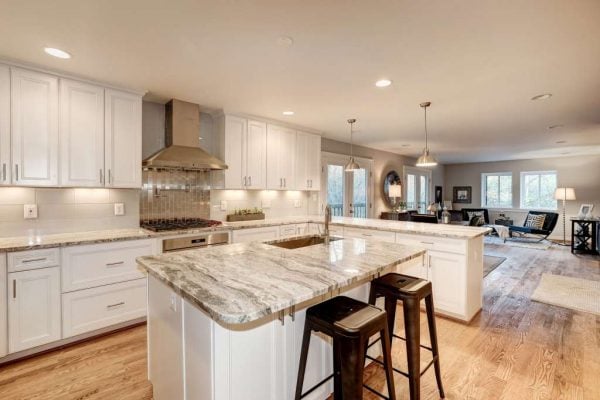This is a sponsored post by Anna Gibson, owner of AKG Design Studio and an award-winning, certified kitchen and bathroom designer. AKG Design Studio is a boutique design firm specializing in kitchen, bathroom designs and cabinetry sales. Contact her at 571-989-2541 or [email protected], and follow her work on Houzz; Pinterest; Facebook and Twitter.
This is part two of the history of the kitchen. (See Part 1 here.) The last 100 years have led us to what we have now.
Early 1900s — Ergonomics!
In 1899, the Hoosier Manufacturing Company introduced a free-standing kitchen storage piece, known as the Hoosier Cabinet. Until then, there was no storage in the kitchen and cabinets were built at home as needed.
The unit included space-saving features like upper and lower cabinets, in-cabinet storage spaces for things like flour, sugar and spices, it even featured a pullout work surface! Although the Hoosier Cabinet wasn’t large, it filled the storage void and made working in the kitchen much more efficient.
In the early 1900s, gas became the preferred source of heat that allowed ovens to become smaller and lighter. According to Wikipedia, “The evolution of the kitchen is linked to the invention of the cooking range or stove and the development of water infrastructure capable of supplying running water to private homes.” The industrial revolution brought inventions, cheaper prices, and new ways of thinking about economic and ergonomic efficiency.
Right after the Hoosier kitchen popped up, in 1926 an Austrian architect named Margarete Schütte-Lihotzky create the Frankfurt kitchen, creating in effect the first fitted modern kitchen as we know it today. Base cabinets, wall cabinets, work surface and appliances fit into the space.
The Mid-century Home style, or the Roaring ’40s
The art deco was influencing everything from fashion to vacuum cleaners to the kitchen. The Frankfurt kitchen has taken over the world and the main stream layout and function. Combined with art deco, we got the first highly designed kitchen!
Where in the past kitchens were only a place of utility, with no character, the art deco took over and introduced many of the design elements that we see today like bold geometric lines, strong colors of the Fauvism movement and fine craftsmanship. Homeowners were inspired to take down walls that once enclosed the kitchen in a box, to open spaces for entertaining.
Pre-manufactured modules, using mass-manufacturing techniques developed during World War II, brought down the cost of kitchens, bringing those design options to most households in the US. And, of course, radar technology brought us the first microwave in 1946.
The Feminism Era (’60s-’70s)
Not surprising, but as the feminist movement was growing during the ’60s and as more women joined the workforce, more time-saving appliances took to the market. We got the first coffee machine in 1952 and the holy food processors in 1960, the Starmix MX3. (You can still find some on the original versions floating around on eBay if the KitchenAid is too fancy for you!)
The heavy colors of yellow and gold are a common thread from the ’50 into the ’70s. Appliances are the same color as the cabinets — how about an avocado green fridge and linoleum floor to match? The cabinet doors are flat and clean line, taken over by mix of bright colors. Microwave sales skyrocket and TV dinners a hit on the grocery shelves — from breakfast to dessert they offered all possible varieties.
Kitchens are fun, functional and full of color!
The ’80s: From Kitchen to Cool
We love the music, but the fashion sense left a lot to be desired!
Yes the avocado green left the kitchen and made space for lighter colors, and lots of oak! The kitchen now has various styles, from country to ultra-modern. (Think Griswolds vs. the neighbors across the street.) The beloved work space, the island, was introduced by designer Susan Zises Green in 1985. It was the biggest change in layout since Frankfurt kitchen.
It is in the ’80s that kitchen becomes the heart of the home! Not only video stars were made, but we are also introduced to celebrity cooks on TV who push the design to kitchens that equipped with more and more “show-off” items to guests, open to the living spaces and providing areas for home work, display decorative items and social spaces.
Today’s kitchens are still very similar to the original Frankfurt kitchen, yet the social and technological changes in the past 100 years influenced the function, size and form. Kitchens today are the grand rooms of the past, creating “super kitchens,” the hub of the house and family life.







